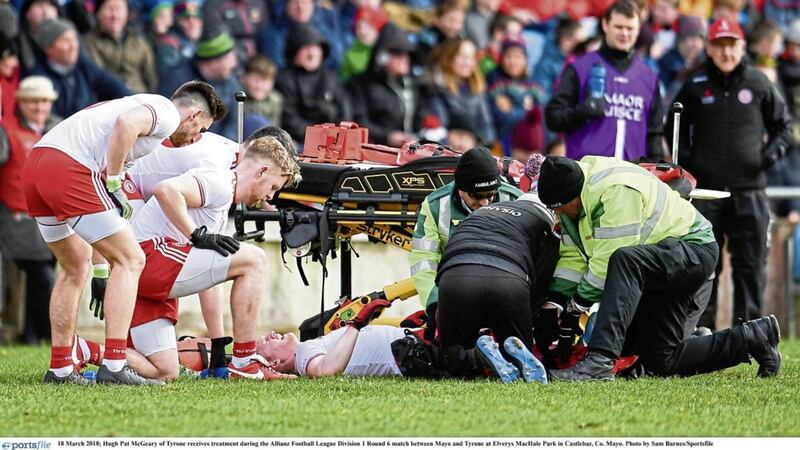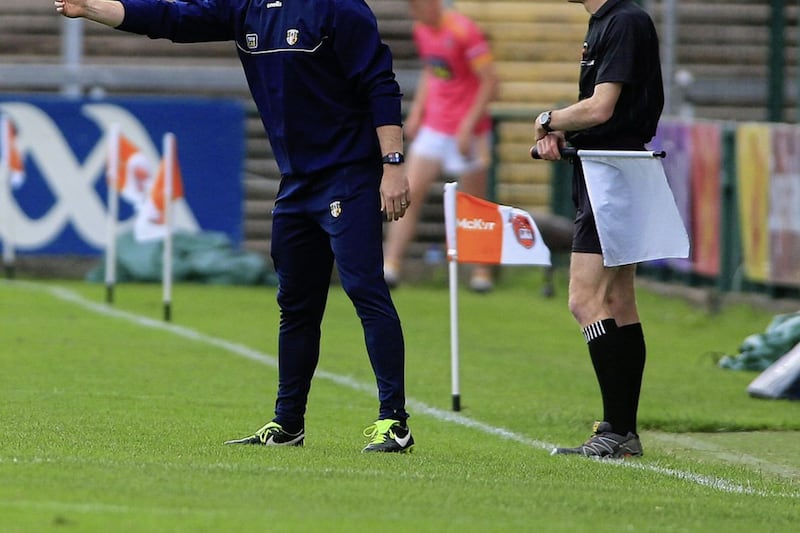SOMETIMES it’s hard to beat (or perhaps avoid) revisiting old favourites. As a person who suffered my fair share of injuries during my playing career and as someone who, as a physiotherapist, sees first hand the impact such injuries can have, I’ve always had a keen interest in our rules surrounding dangerous play, ie play that can endanger an opponent.
Last week’s game between Tyrone and Mayo was a stark reminder of the need to get this area right. Both Hugh Pat McGeary and
Lee Keegan had to leave the field of play with potentially serious injuries because of full-blooded challenges from opponents.
The tackle in Gaelic football has been a source of annoyance and inconsistency since the inception of the game.
It has stubbornly refused to allow itself to be defined in a way which can be practically and consistently applied in game situations.
Yes, it is there in black and white in the rulebook, but this is rendered ineffectual when viewed in the context of game situations, especially in the modern context where turnovers are most likely to arise from a swarm tackle rather than a 1:1 dual.
The issue is compounded further when we look at the higher-grade offences which merit yellow, red or black cards and, particularly when we look at the area of dangerous play.
It is stated that any play which is dangerous to an opponent is a category III offence and merits a red card.
Unfortunately, in the preamble at the start of the section detailing aggressive fouls, it states that all of the following sanctions are purely for deliberate actions and not appropriate for accidental collisions or infractions.
Last Sunday, Padraig McNulty of Tyrone got a red card for his hit on Lee Keegan.
Due to the force and opposing speeds of the two players, it was a sickening type of hit demonstrated by the immediate concern for the injured party.
In saying that, there was plenty of sympathy for McNulty as it looked like he was trying to initiate a catch of the ball only for Keegan to get the arm in front of him and get hit by McNulty’s flying midriff/hip.
Certainly, I would doubt that McNulty had any intentions other than to try to win, or at the very least contest, the ball. He was arguably preparing and protecting himself from the potential hit of Keegan.
In my opinion, Colm Boyle’s incident was not as defensible as the ball was gone before Boyle launched into McGeary in what could, at best, be described as a clumsy tackle.
For me the issue of ‘intention’ in the two described examples should not be allowed to get in the way of trying to eradicate these types of hits from our game.
Like many areas of discipline it is hard not to cast an envious eye towards the oval ball game. The absence of dissent from players and staff towards referee decisions has always been admirable, but it is in addressing dangerous play that rugby union particularly leads the way.
Rugby has taken many steps to try to mitigate the chance of injury that naturally comes with the massively physical nature of the game.
For example, they have specific rules that if a player lifts an opponent into the air, that player is responsible for putting them SAFELY back down to the ground. They are very clear in terms of dangerous play. It is up to the tackling player to be in control. In rucks or tackles, if a player connects with an opponent’s head, it is their responsibility.
I have seen many examples over the past year where there was no malicious intent, but if feet were off the ground when making the hit or if contact was made with the head first, it was case closed and the player was red-carded. It’s telling that in rugby, a more physical game than ours and one where they are trained specifically in giving and taking hits, both O’Boyle’s and McNulty’s tackles would have merited straight red cards. In GAA, we focus on whether there is a legitimate attempt to play the ball or if the contact was accidental.
Given the pace, strength and power of our players now, the forces in impacts are greater than ever before and our approach needs to come up to scratch accordingly.
It is critical for avoidance of unnecessary injury that players realise they have a duty to other players to always be in control of their body and to avoid potentially injurious contact especially involving the head. The fear here is, of course, that we remove the physicality of our game, something that has already changed a great deal in the past few decades.
However, if rugby can find that balance surely we can in our own games too. We must move on from the kamikaze life lessons we were all taught as kids regarding going into tackles: (a) never pull out and (b) if you go in hard enough you won’t get hurt.
When on this theme, the other type of tackle that is under-respected and needs to be outlawed is the frontal tackle when someone is picking up a ball. In this scenario, a player is bent over, picking up the ball with their face facing the turf. An opponent rushes in from the front and makes contact with the top of the head, often with the knee.
I have had a few neck injuries and this is the tackle that always makes me wince.
The mechanism involved in this scenario is perfect to induce a forced compression and flexion of the neck which is one of the most potentially devastating mechanisms from a spinal injury point of view.
Yet this tackle usually goes completely unpunished. Compare this to the big roar and baying for punishment from opponents or crowd if someone does the classic ‘clothes line’ tackle which, although looking dramatic, is not a particularly injurious mechanism unless carried out at full speed, which I can’t recall ever seeing.
Concussion and player welfare are two big topics in GAA. We must start with the basics, however, and accept that avoidance of unnecessary or dangerous collisions is possible, even in a contact sport. It will take education and a culture change and some rewriting of rules – but, as ever, when it comes to injury, prevention is much better than cure.







